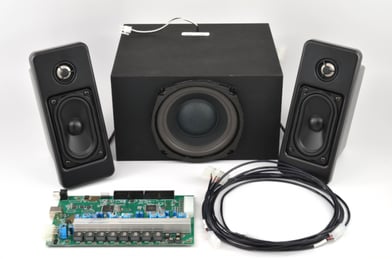The Advantages of a Bi-Amp Audio System
If you want a quick win for improving the sound quality in an audio system, bi-amping (or tri-amping) is a good place to start. It gives you far greater control over your sound. By using one amp to power the low frequency speakers (woofers) in a system and a separate one to power the high frequency speakers (or tweeters), users can achieve application-specific sound settings and a more consistent overall level of volume.
Additionally, bi-amping can reduce distortion and noise in a system. Ultimately, this results in clearer and more accurate sound reproduction. Bi-amping is standard in professional audio applications such as recording studios and live music venues. However, it is also well suited for use in any setting where high-quality sound reproduction is desired.
Reduced Risk of Distortion
Some level of distortion will always be present in an audio system–although it may not always be audibly perceptible. One way distortion can occur is if a speaker tries to reproduce frequencies it wasn’t designed for (i.e. sending a bass signal to a tweeter).
Passive crossovers like resistors, capacitors, and inductors can contribute to distortion. These components have a limitation in that they don’t always provide a sharp roll-off, and portions of an unintended frequency band may bleed through. Passive crossover components can also zap systems of some of their output power because what they are essentially doing is siphoning power away from the speakers since they are placed between the amplifier output and the speakers. This process converts the energy that would normally become sound into heat. A passive system with 4th order filters may lose up to 20% of its power this way.
Active crossovers, available with digital signal processing (DSP)-enabled amplifiers are better at providing customization and control over the slope and shape of a filter. Think of DSP as an audio mixing board that is continuously filtering a signal with lightning-fast computing power. This, by itself, can help reduce the distortion in a system while restoring the power lost in a passive system since everything is performed before the amplifier output stage.
Going a step further and bi-amping your multi-speaker systems offers an even greater level of audio clarity and control. Here are three specific sound quality advantages it offers:
- Intermodulation distortion is caused when different frequencies interact and produce additional frequencies at the harmonics and the sums of the original frequencies. This can create a muddy sound. An active bi-amp’d or tri-amp’d system is less susceptible to this because the woofer and tweeter channels are driven by separate amplifiers.
- Greater vibrancy and sound definition is achieved with bi-amping. In a passive system, the capacitors and inductors in series between the amp and the driver, reduce efficiency and can impart their own sonic characteristics. In a bi-amp system, the amplifiers connect directly to the speaker coils without other components being in the way to lessen their effectiveness.
- A bi-amplified speaker system with DSP often has delay control. The ability to delay different speaker drivers by different amounts of time (in micro or milliseconds) allows the drivers to be “time-aligned”. This feature helps to ensure that the sound waves from the different drivers arrive to the listener at the same time.
Designing a Quality Bi-Amped System
Selecting the proper amping strategy and working with a speaker manufacturer with proven expertise are both part of creating a quality audio system. 
A good example of this is the TK-403 2.2.1 channel audio system. The goal for it was to create an immersive surround sound experience. To achieve this, both the midrange driver and the tweeter in the satellite speakers have their own amp. By bi-amping the system, the need for passive crossovers was avoided, which could have introduced distortion.
The amplifiers in this system can offer up to 175W total power output. This is achieved, in part, because the amps run cool and don’t generate heat by passing the signal through passive components.

